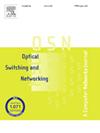Elastic Optical Networks (EONs) allow the channel spacing and the spectral width of an optical signal to be dynamically adjusted and hence have become an important paradigm in managing the heterogeneous bandwidth demands of optical backbone networks. The entire available optical spectrum is divided into some spectrum slots which define the smallest granularity of bandwidth and optical signals with variable bandwidths can occupy different number of such slots. The constraints imposed by the physical layer of an EON require that the slots occupied by an optical signal from source to destination have to be consecutive and contiguous in terms of their relative position in the optical spectrum. Furthermore, the same spectrum slots need to be reserved throughout the entire optical signal's path from its source to destination. The above constraints make the routing and spectrum allocation (RSA) in EONs very challenging because unavailability of enough spectrum slots that together equals the spectral width of the optical signal associated with an end-to-end request, will result in blocking of the request. Recent developments in the physical layer technologies have made all-optical ‘slicing’ of a request possible and make the request to be ‘fit’ into multiple non-consecutive spectral slots in an EON. But these all-optical ‘slicers’ employ complex technologies and can be very costly to employ. In this paper, we propose a spectrum allocation scheme for an EON node architecture with these ‘slicers’ and we also formulate a modified RSA scheme for EONs employing slicers, both as a mixed-integer linear programming (MILP) model and a heuristic algorithm. Our main aim is to analyze the tradeoff between the number of slicers that can be used per node versus the spectrum utilization and bandwidth blocking rate. The numerical results show that the proposed scheme with slicers can significantly improve bandwidth blocking rate, compared to the conventional scheme without slicer.


